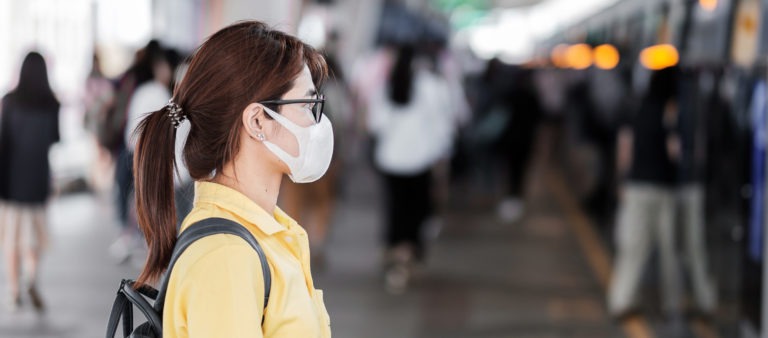When Did COVID-19 Transmission Begin?
“Symptom onset of the 41 confirmed nCoV cases ranges from 8 December 2019 to 2 January 2020” (WHO, “Novel Coronavirus – China: Disease outbreak news : Update,” (01-12-2020).
When Did WHO Find Out About COVID-19 Transmission?
“Recently. . . many of the pneumonia cases received were related to South China Seafood City. . . Twenty-seven cases have been found, of which seven are severely ill. . . All cases have been treated in isolation. . . The above cases are considered to be viral pneumonia. The investigation so far found no obvious person-to-person transmission, and no medical personnel have been infected. . . The disease can be prevented and controlled by preventing indoor air circulation, avoiding public places where there is no air circulation and places where people are concentrated, and wearing masks when going out” (Wuhan City Health Committee, 12-31-2019).
“On 11 and 12 January 2020, WHO received further detailed information from the National Health Commission about the [COVID-19] outbreak. WHO is reassured of the quality of the ongoing investigations and the response measures implemented in Wuhan, and the commitment to share information regularly. The evidence is highly suggestive that the outbreak is associated with exposures in one seafood market in Wuhan. The market was closed on 1 January 2020. At this stage, there is no infection among healthcare workers, and no clear evidence of human to human transmission. The Chinese authorities continue their work of intensive surveillance and follow up measures, as well as further epidemiological investigations. . . China shared the genetic sequence of the novel coronavirus on 12 January, [2020], which will be of great importance for other countries to use in developing specific diagnostic kits. The cluster was initially reported on 31 December 2019, when the WHO China Country Office was informed. The Chinese authorities identified a new type of coronavirus (novel coronavirus, nCoV), which was isolated on 7 January 2020. . . Symptom onset of the 41 confirmed nCoV cases ranges from 8 December 2019 to 2 January 2020. No additional cases have been detected since 3 January 2020. . . According to the preliminary epidemiological investigation, most cases worked at or were handlers and frequent visitors to the Huanan Seafood Wholesale Market. The government reports that there is no clear evidence that the virus passes easily from person to person. Currently, no case with infection of this novel coronavirus has been reported elsewhere other than Wuhan. . . China’s National Health Commission has deployed a group of experts to Wuhan City to support the local response. National authorities have reported the following response measures: a total of 763 close contacts including healthcare workers, have been identified and followed up and no additional cases of infection with the novel coronavirus have been identified; the Wuhan Municipal Health Commission carried out active case finding, and retrospective investigations of the current cluster of patients have been completed; the Huanan Seafood Wholesale Market has been temporarily closed to carry out environmental sanitation and disinfection; public risk communication activities have been carried out to improve public awareness and adoption of self-protection measures. WHO does not recommend any specific health measures for travelers. In case of symptoms suggestive of respiratory illness either during or after travel, travelers are encouraged to seek medical attention and share travel history with their healthcare provider. Travel guidance has been updated. WHO advises against the application of any travel or trade restrictions on China based on the information currently available on this event” (WHO, “Novel Coronavirus – China: Disease outbreak news : Update,” (01-12-2020).
“On 31 December 2019, the WHO China Country Office was informed of cases of pneumonia unknown etiology (unknown cause) detected in Wuhan City, Hubei Province of China. From 31 December 2019 through 3 January 2020, a total of 44 case-patients with pneumonia of unknown etiology were reported to WHO by the national authorities in China. During this reported period, the causal agent was not identified. On 11 and 12 January 2020, WHO received further detailed information from the National Health Commission China that the outbreak is associated with exposures in one seafood market in Wuhan City. . . Cases in Thailand, Japan and Republic of Korea were exported from Wuhan City, China. . . The Huanan Seafood Wholesale Market in Wuhan city was closed on 1 January 2020 for environmental sanitation and disinfection. Market inspection in expansion to other markets. . . In the way of “preparedness and response,” WHO has “provided recommendations to reduce risk of transmission from animals to humans” WHO, “Situation Report 1,” 01-21-2020).
“Of the 309 confirmed cases in China, 270 cases were confirmed from Wuhan. . . To date, sixteen health care workers have been infected. . . Cases have been reported in seven additional provinces and two municipalities. One case was reported in Taiwan, China. . . As of 21 January, 16 cases have been reported among health care workers in Wuhan. Detailed exposure information from these health care workers is not currently available to WHO. . . In the way of “preparedness and response,” WHO has “provided recommendations to reduce risk of transmission from animals to humans . . . WHO has issued interim guidance for countries, updated to take into account the current situation”. . . In Korea, “Contact tracing and other epidemiological investigation are underway” (WHO, “Situation Report 2,” 01-22-2020).
“A total of 581 confirmed cases have been reported for novel coronavirus (2019-nCoV) globally; of the 581 cases reported, 571 cases were reported from China. . . The initial source of 2019-nCoV still remains unknown. However, it is clear the growing outbreak is no longer due to ongoing exposures at the Huanan seafood market in Wuhan; as in the last one week, less than 15% of new cases reported having visited Huanan market. There is now more evidence that 2019-nCoV spreads from human- to- human and also across generations of cases. . . WHO assesses the risk of this event to be very high in China, high at the regional level and high at the global level. . . WHO’s surveillance data on this date demonstrates the first case in the United States. . . In the way of “preparedness and response,”. . . “WHO has been in regular and direct contact with Chinese as well as Japanese, Korean and Thai authorities since the reporting of these cases. The three countries have shared information with WHO under the International Health Regulations. WHO is also informing other countries about the situation and providing support as requested. . . [has] provided recommendations to reduce risk of transmission from animals to humans. . . WHO is working with our networks of researchers and other experts to coordinate global work on surveillance, epidemiology, modelling, diagnostics, clinical care and treatment, and other ways to identify, manage the disease and limit onward transmission. WHO has issued interim guidance for countries, updated to take into account the current situation. . . On 7 January 2020, the US CDC established a 2019-nCoV Incident Management Structure. On 21 January 2020, US CDC activated its Emergency Response System to better provide ongoing support to the 2019-nCoV response. On 21 January 2020, US CDC again updated its interim travel health notice for persons traveling to Wuhan city, China. The travel notice was raised from Level 1; Practice Usual Precautions, to a Level 2: Practice Enhanced Precautions advising travelers that preliminary information suggests that older adults with underlying health conditions may be at increased risk for severe disease. CDC began entry screening of passengers on direct and connecting flights from Wuhan China to the 3 main ports of entry in the United States on 17 January 2020 and will expand the screening to Atlanta and Chicago in the coming days. CDC issued an updated interim Health Alert Notice (HAN) Advisory to inform state and local health departments and health care providers about this outbreak on 17 January 2020. A CDC team has deployed a team to support the ongoing investigation in the state of Washington in response to the first reported case of 2019-nCoV in the United States, including potentially tracing close contacts to determine if anyone else has become ill. • CDC has developed a rRT-PCR test that can diagnose 2019-nCoV” (WHO, “Situation Report 3,” 01-23-2020).
“A total of 846 confirmed cases have been reported for novel coronavirus (2019-nCoV) globally; of the 846 cases reported, 830 cases were reported from China. . . One confirmed case in Vietnam had no travel history to any part of China but was a family member of a confirmed case who visited Wuhan. This suggests an instance of human to human transmission that occurred in Vietnam. . . New epidemiological information reinforces the evidence that the 2019-nCoV can be transmitted from one individual to another. . . The strategic objectives of the response are to interrupt the transmission of the virus from one person to another in China, to prevent exportation of cases from China to other countries and territories, and to prevent further transmission from exported case if they were to happen.”. . . At this point, there is still the one case in the United States. In the way of “preparedness and response,”. . . “• WHO has published an updated advice for international traffic in relation to the outbreak of the novel coronavirus 2019-nCoV; • WHO has been in regular and direct contact with Chinese as well as Japanese, Korean and Thai authorities since the reporting of these cases. The three countries have shared information with WHO under the International Health Regulations. WHO is also informing other countries about the situation and providing support as requested.” In China, “As of 23 January, the National Health Commission revised protection standards and specifications for medical workers and strengthened prevention and control measures against 2019-nCoV in hospitals” (WHO, “Situation Report- 4,” 01-24-2020).
Sources Cited
World Health Organization. “Novel Coronavirus (2019-nCoV) Situation Report – 1 (January 21, 2020). Accessed April 2, 2020. https://www.who.int/docs/default-source/coronaviruse/situation-reports/20200121-sitrep-1-2019-ncov.pdf?sfvrsn=20a99c10_4.
World Health Organization. “Novel Coronavirus (2019-nCoV) Situation Report – 2 (January 22, 2020). Accessed April 2, 2020. https://www.who.int/docs/default-source/coronaviruse/situation-reports/20200122-sitrep-2-2019-ncov.pdf?sfvrsn=4d5bcbca_2.
World Health Organization. “Novel Coronavirus (2019-nCoV) SITUATION REPORT – 3 (January 23, 2020). Accessed April 2, 2020. https://www.who.int/docs/default-source/coronaviruse/situation-reports/20200123-sitrep-3-2019-ncov.pdf?sfvrsn=d6d23643_8.
World Health Organization. “Novel Coronavirus (2019-nCoV) SITUATION REPORT – 4 (January 24, 2020). Accessed April 2, 2020. https://www.who.int/docs/default-source/coronaviruse/situation-reports/20200124-sitrep-4-2019-ncov.pdf?sfvrsn=9272d086_8.
World Health Organization. “Novel Coronavirus – China: Disease outbreak news : Update” (January 12, 2020). Accessed April 3, 2020. https://www.who.int/csr/don/12-january-2020-novel-coronavirus-china/en/.
Wuhan City Health Committee. “Wuhan Municipal Health and Health Commission’s Briefing on the Current Pneumonia Epidemic Situation in Our City” (12-31-2019). Translated by Google. Accessed April 3, 2020. http://wjw.wuhan.gov.cn/front/web/showDetail/2019123108989.


